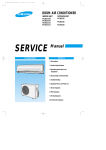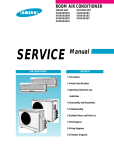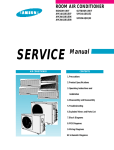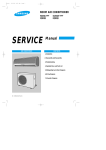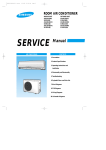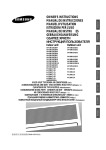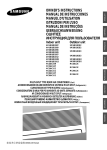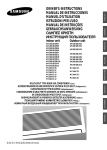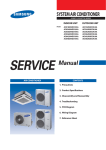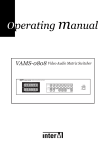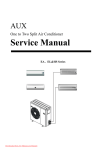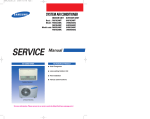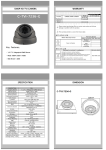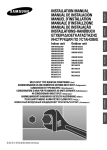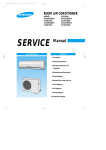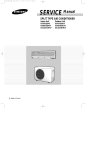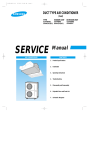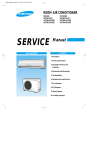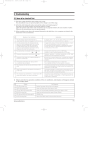Download Samsung MC26AC2X Service manual
Transcript
DB98_11868A(1)_cover 3/3/03 11:16 AM Page 3 ROOM AIR CONDITIONER INDOOR UNIT OUTDOOR UNIT MC26AC2-07 MC26AC2-12 MC26AC2X SERVICE Manual AIR CONDITIONER CONTENTS 1. Precautions 2. Product Specifications 3. Operating Instructions and Installation 4. Disassembly and Reassembly 5. Troubleshooting 6. Exploded Views and Parts List 7. Block Diagrams 8. PCB Diagrams 9. Wiring Diagrams 10. Schematic Diagrams DB98_11868A(1)_1 3/3/03 11:17 AM Page 1-1 1. Precautions 1. Warning: Prior to repair, disconnect the power cord from the circuit breaker. 2. Use proper parts: Use only exact replacement parts. (Also, we recommend replacing parts rather than repairing them.) 3. Use the proper tools: Use the proper tools and test equipment, and know how to use them. Using defective tools or test equipment may cause problems later-intermittent contact, for example. Fig. 1-1 Avoid Dangerous Contact 4. Power Cord: Prior to repair, check the power cord and replace it if necessary. 5. Avoid using an extension cord, and avoid tapping into a power cord. This practice may result in malfunction or fire. 6. After completing repairs and reassembly, check the insulation resistance. Procedure: Prior to applying power, measure the resistance between the power cord and the ground terminal. The resistance must be greater than 30 megaohms. Fig. 1-2 No Tapping and No Extension Cords 7. Make sure that the grounds are adequate. 8. Make sure that the installation conditions are satisfactory. Relocate the unit if necessary. 9. Keep children away from the unit while it is being repaired. 10. Be sure to clean the unit and its surrounding area. Fig. 1-3 No Kids Nearby! Fig. 1-4 Clean the Unit Samsung Electronics 1-1 DB98_11868A(1)_1 3/3/03 11:17 AM Page 1-2 MEMO 1-2 Samsung Electronics DB98_11868A(1)_1 3/3/03 11:17 AM Page 2-1 2. Product Specifications 2-1 Table MC26AC2 Model Item INDOOR UNIT INDOOR UNIT OUTDOOR UNIT MC26AC2-07 MC26AC2-12 MC26AC2X Type Wall-Mounting Multi Split kW 2.05 x 2 3.5 7.6 BTU/h 6,995 x 2 11,942 25,932 Kcal/h 1,763x2 3,009 6,535 \/h 0.9 1.5 - m3/min 6 8 - Noise dB 39 42 60 Power ø-V-Hz Cooling Performance Dehumidifying Air volume Power 1-220-240V~, 50Hz Power Consumption W 1,250 1,210 2,460 Operating Current A 5.5 5.4 10.9 Starting Current 30 A Power Cord (Option) 2.5 x 3core Connection Cable (Option) 1.0 x 4core Fuse Capacity Outer WxHxD Dimension Weight A 3.15 3.15 - mm 790 x 245 x 165 790 x 245 x 165 880 x 638 x 310 inch 31.1 x 9.64 x 6.50 31.1 x 9.64 x 6.50 34.65 x 25.1 x 12.2 kg 7.7 7.7 60 Liquid OD(mm)xL(m) ø6.35 x 5 ø6.35 x 5 - Gas OD(mm)xL(m) ø9.52 x 5 ø9.52 x 5 - OD(mm)xL(m) ø18.0 x 2 ø18.0 x 2 - Type - - Rotary Model name - - Capacitor - Refrigerant pipe Drain hose A : G8C124JU1EL Size Compressor B : G8C124JU1EL A : 35µF 450VAC Motor B : 35µF 450VAC Type Rated output W Type Blower Motor Type Rated output - W Heat exchanger - - - - A : 1,060, B : 1,060 Resin Resin Steel Cross-flow Cross-flow Propeller 22 22 74 2Row 12Step 2Row 12Step 2Row 36Step A/B-Unit : Capillary tube Refrigerant control unit A : 500 Freezer oil capacity cc - - B : 500 A-Unit : 920g, B-Unit : 970g Refrigerant to charge(R410A) A : RAC12128-9622 Protection device - B : RAC12128-9622 Cooling test condition Indoor unit : DB27˚C WB19˚C Outdoor unit : DB35˚C WB24˚C Maximum operation condition Indoor unit : DB32˚C WB23˚C Outdoor unit : DB43˚C WB26˚C Samsung Electronics 2-1 DB98_11868A(1)_1 3/3/03 11:17 AM Page 2-2 2-2 Dimensions 2-2-1 Indoor Unit (Unit : mm) (Front view) 245 Air in 790 165 Air out 115 (Remote control) 45 22 Installation plate 2-2 Samsung Electronics DB98_11868A(1)_1 3/3/03 11:17 AM Page 2-3 Product Specifications 2-2-2 Outdoor Unit 310 (Unit : mm) (Rear view) 796 (Front view) 660 1000 Samsung Electronics 340 2-3 DB98_11868A(1)_1 3/3/03 11:17 AM Page 2-4 2-3 Pressure Graph ■ MC26AC2-07 ■ 10 30.6/22.5 9 27/19 2 Low Pressure [kg/cm G] 11 21.5/14.6 8 7 20 30 40 Outdoor drybulb temperature [deg C] ■ MC26AC2-12 ■ 10 9 2 Low Pressure [kg/cm G] 30.6/22.5 27/19 8 21.5/14.6 7 6 20 30 40 Outdoor drybulb temperature [deg C] 2-4 Samsung Electronics DB98_11868A(1)_1 3/3/03 11:17 AM Page 2-5 3. Operating Instructions and Installation 3-1 Operating Instructions 3-1-1 The Feature of Key in remote controller NO FUNCTION OF KEY NAMED OF KEY Power On/Off button to start and stop airconditioner or timer set up. 1 (UP) Temp. up button. To increase the temperatute by the pressing the temperature button. (DOWN) Temp. down button. To decrease the temperature by the pressing the temperature button. 2 Each time you press this button Mode is changed in the following order 3 : Auto Mode : Dry Mode : Cool Mode : Fan Only Press until the appearance. The air condition cools the room as quickly as possible. After 30minutes, the air, the airconditioner is reset automatically to the previous mode. 4 Press until the appearance. The sleep timer can be used when you are cooling your room to switch the air conditioner off automatically after a period of six hours. 5 Each time you press this button, FAN SPEED is changed in the following order. 6 Adjust air flow vertically. 7 The ON Timer enables you to switch on the air conditioner automatically after a given period of time that is from 30 minutes to 24 hours. To cancel the On Time, press the (Set/Cancel) button. 8 The Off Timer enables you to switch off the air conditioner automatically after a given period of time that is from 30 minutes to 24 hours. To cancel the Off Time, press the (Set/Cancel) button. To select the 5 way function with the remote control, press the 5 way button one or more times until the desired mode is selected. Each time you press the 5 way button. 9 Each 5 way indicator on the indoor unit comes on in order. Samsung Electronics 3-1 DB98_11868A(1)_1 3/3/03 11:17 AM Page 2-6 Operating Instructions and Installation 3-1-2 Name & Function of Key in remote controller 1. AUTO MODE : In this mode, operation COOL mode is selected automatically by the room temperature of initial operation. Operation Type Cool Operation Room Temp Tr≥25°C+∆T Compressor ON Tr<24°C+∆T Compressor OFF ∆T= -1°C, -2°C, 0°C+1°C+2°C ∆T is controlled by setting temperature up/down key of remote controller * FAN SPEED : AUTO 2. COOL MODE : The unit operates according to the difference between the setting and room temperature. (18°C~30°C) 3. DRY MODE : Has 3 states, each determined by room temperature. The unit operates in DRY mode. *Compressor ON/OFF Time is controlled compulsorily(can not set up the fan speed, always breeze). *Protective function : Low temperature release. (Prevention against freeze) 4. TURBO MODE : This mode is available in AUTO, COOL, DRY, FAN MODE. When this button is pressed at first, the air conditioner is operated “powerful” state for 30 minutes regardless of the set temperature, room temperature. When this button is pressed again, or when the operating time is 30 minutes, turbo operation mode is canceled and returned to the previous mode. *But, if you pressed the TURBO button in DRY or FAN mode that is changed with AUTO mode automatically. 3-2 5. SLEEP MODE : Sleep mode is available only in COOL mode. The operation will stop after 6 hours. *The setting temperature is automatically raised by 1°C each 1hour When the temperature has been raised by total of 2°C, that temperature is maintained. 6. FAN SPEED : Manual (3 step), Auto (4 step) Fan speed automatically varies depending on both the difference between setting and the room temperature. 7. COMPULSORY OPERATION : For operating the air conditioner without the remote controller. *AUTO : The operating is the same function that AUTO MODE in the remote controller. And each time you press the button the 5WAY function is changed as follow. STD ➝ NATURE ➝ POWER ➝ SAVING ➝ SILENCE ➝ POWER OFF ❊ STD(standard)( ) : General operation Mode ❊ NATURE( ) : The unit is operated according to health pattern control ❊ POWER( ) : The unit is operated in powerful state ❊ SAVING( ) : The unit is operated in power saving state ❊ SILENCE( ) : The unit is operated quietly Each mode has Auto, Cool and SLEEP operation designed in advance. Samsung Electronics DB98_11868A(1)_1 3/3/03 11:17 AM Page 2-7 Operating Instructions and Installation 8. SWING : BLADE-H is rotated vertically by the stepping motor. *Memory louver : When ON/OFF button is pressed at stop state, the BLADE-H returns to its original location which is operating state before stop *Swing Set : Press the button under the remote control is displayed on LCD the and the blades move up and down. If the one more time press the button, blades location is stop. 10. SELF Diagnosis LED DISPLAY STD NATURE POWER SAVING SILENCE TIMER Check Point Indoor unit room temperature sensor error(open or short) Indoor unit heat exchanger temperature sensor error(open or short) Indoor fan mal function 9. 24-Hour ON/OFF Real Setting Timer. : The air conditioner is turned ON at a specified time using . OFF TIMER : The air Conditioner is turned OFF at a specified time using . *ON TIMER : Only timer LED lights on. *OFF TIMER : Both timer and operation LED lights on. EEPROM error Option error(option wasn’t set up or option data error) : LED blinking : LED off 11. BUZZER SOUND : Whenever the ON/OFF button is pressed or whenever change occurs to the condition which is set up or select, the compulsory operation mode, buzzer is sounded "beep". Samsung Electronics 3-3 DB98_11868A(1)_1 3/3/03 11:17 AM Page 2-8 3-2 Installation 3-2-1 Selecting Area for Installation Select an area for installation that is suitable to the customer's needs. 3-2-1(a) Indoor Unit 1. Make sure that you install the indoor unit in an area providing good ventilation. It must not be blocked by an obstacle affecting the airflow near the air inlet and the air outlet. 2. Make sure that you install the indoor unit in an area allowing good air handling and endurance of vibration of the indoor unit. 3. Make sure that you install the indoor unit in an area where there is no source of heat or vapor nearby. (Fix the unit firmly if it is mounted in a high place.) 3. Make sure that you install the outdoor unit in area providing good ventilation and which is not dusty. It must not be blocked by any obstacle affecting the airflow near the air inlet and the air outlet. 4. Make sure that you install the outdoor unit in area free from animals or plants. 5. Make sure that you install the outdoor unit in area not blocking the traffic. 6. Make sure that you install the outdoor unit in area easy to drain condensed water from the indoor unit. 5. Make sure that you install the indoor unit in an area away from TVs, audio units, cordless phones, fluorescent lighting fixtures and other electrical appliances (at least 1 meter). 7. Make sure that you install the outdoor unit in area which provides easy connection within the maximum allowable length of a coolant pipe(10 meters). Note 1. Add 10 grams of refrigerant (R410A) for every 1 meter if the pipe length exceeds the standard pipe length of 5 meters. 2. Maintain a height between the indoor and outdoor units of less than 3 meters. 6. Make sure that you install the indoor unit in an area which provides easy pipe connection with the outdoor unit, and easy drainage for condensed water. 8. Make sure that you install the outdoor unit in an area which is large enough to accommodate the measurements shown in figure on the next page. 4. Make sure that you install the indoor unit in an area from which hot or cool air is spread evenly in a room. 7. Make sure that you install the indoor unit in an area which is large enough to accommodate the measurements shown in figure on the next page. 3-2-1(b) Outdoor Unit 1. Make sure that you install the outdoor unit in area not exposed to the rain or direct sun light. (Install a separate sunblind if exposed to direct sun light.) 2. Make sure that you install the outdoor unit in area allowing good air moment, not amplifying noise or vibration, especially to avoid disturbing neighbours. 3-2-1(c) Remote Control Unit 1. Make sure that you install the remote control unit in an area free from obstacles such as curtains etc, which may block signals from the remote control unit. 2. Make sure that you install the remote control unit in an area not exposed to direct sunlight, and where there is no source of heat. 3. Make sure that you install the remote control unit in an area away from TVs, audio units, cordless phones, fluorescent lighting fixtures and other electrical appliances (at least 1 meter). Caution : It is harmful to the air conditioner if it is used in the following environments: greasy areas (including areas near machines), salty areas such as coast areas, areas where sulfuric gas is present such as hot spring areas. Contact your dealer for advice. 3-4 Samsung Electronics DB98_11868A(1)_1 3/3/03 11:17 AM Page 2-9 Operating Instructions and Installation 3-2-2 Installation diagram of indoor unit and outdoor unit A Indoor unit gas leak test check point Indoor unit Piping may be laid to the rear, left, right or down . 3 Left Right 2 Rear Piping Rear Down Tape vinyl 30mm or more 1 B Drain hose installation 125mm or more 125mm or more Cut the piping hole sloped slightly 7 A 5 B 6 100 mm 600mm or more Remote control or m ore 4 100 mm or m A-UNIT 600m m or ore Outdoor unit check point B-UNIT more 10 1 Piping (Liquid) 1/4" 6 Clamper tube 2 Piping (Gas) 3/8" 7 Installation plate 3 Installation tube 8 Pipe-connection 4 Vinyl tape 9 Screw 5 Putty 10 Drain hose Samsung Electronics 3-5 DB98_11868A(1)_1 3/3/03 11:17 AM Page 2-10 Operating Instructions and Installation 3-2-2(a) Fixing the Installation Plate 1. Determine the position of the pipe and drain hose hole using the right figure and drill the hole with an inner diameter of 65mm so that it slants slightly downwards. Installation plate Pipe hole (ø65mm) 2. If you are fixing the indoor unit to a… Then follow Steps… 3. Window frame 4 to 6. 3. Fix the installation plate to the wall in a manner appropriate to the weight of the indoor unit. 60 (Unit : mm) 252 If you are mounting the plate on a concrete wall with anchor bolts, the anchor bolts must not project by more than 20mm. 275 30 90 Wall 140 4. Determine the positions of the wooden uprights to be attached to the window frame. 410~730 (Unit : mm) 5. Attach the wooden uprights to the window frame in a manner appropriate to the weight of the indoor unit. 6. Using tapped screws, attach the installation plate to the wooden uprights, as illustrated in the last figure opposite. 3-2-2(b) Purging the Unit On delivery, the indoor unit is loaded with an inert gas. All this gas must therefore be purged before connecting the assembly piping. To purge the inert gas, proceed as follows. Unscrew the caps at the end of each pipe. Result : All inert gas escapes from the indoor unit. • 3-6 To prevent dirt or foreign objects from getting into the pipes during installation, do NOT remove the caps completely until you are ready to connect the piping. Samsung Electronics DB98_11868A(1)_1 3/3/03 11:17 AM Page 2-11 Operating Instructions and Installation 3-2-2(c) Connecting the Assembly Cable. The outdoor unit is powered from the indoor unit via the assembly cable. If the outdoor unit is more than five metres away from the indoor unit, the cable must first be extended to a maximum of ten metres. 1. Extend the assembly cable if necessary. 2. Open the front grille by pulling on the tabs on the lower right and left sides of the indoor unit. 3. Remove the screw securing the connector cover. Indoor unit 4. Pass the assembly cable through the rear of the indoor unit and connect the assembly cable to terminals N1 to 1. 1 2 3 E • Each wire is labelled with the corresponding terminal number. Earth terminal 5. Firmly fix the ass’y cable with clamp wire holder. Outdoor 1 unit 2 3 1 2 3 (L) (N) COM Earth terminal E 6. Pass the other end of the cable through the 65mm hole in the wall. E 7. Replace the connector cover, carefully tightening the screw. 8. Close the front grille. 9. For further details on how to plug the other end of the assembly cable into the outdoor unit, refer to page 3-8. 3-2-2(d) Installing and Connecting the Indoor Unit Drain Hose Care must be taken when installing the drain hose for the indoor unit to ensure that any condensation water is correctly drained outside. When passing the drain hose through the 65mm hole drilled in the wall, check that none of the following situations occur. 5cm less The hose must NOT slope upwards. The end of the drain hose must NOT be placed in water. Do NOT bend the hose in different directions. Keep a clearance of at least 5cm between the end of the hose and the ground. Do NOT place the end of the drain hose in a hollow. To install the drain hose, proceed as follows. 1. If necessary, connect the 2-metre extension to the drain hose. 2. If you are using the extension, insulate the inside part of the extension drain hose with a shield. 3. Pass the drain hose under the refrigerant piping, taking care to keep the drain hose tight. 4. Pass the drain hose through the hole in the wall, making sure that it is sloping downwards, as shown in the illustrations above. The hose will be fixed permanently into position once the whole installation has been tested for gas leaks; Shield Drain hose Samsung Electronics Extension drain hose 3-7 DB98_11868A(1)_1 3/3/03 11:17 AM Page 2-12 Operating Instructions and Installation 3-2-2(e) Outdoor unit installation GAS LEAK TEST Outdoor unit check point Indoor unit check point Check for gas leak from the flare nut connections with leak detector. WIRING CONNECTION Two electric cables must be connected to the outdoor unit: • The assembly cable connecting the indoor unit to the outdoor unit. • The power cable connecting the auxiliary circuit breaker to the outdoor unit. 1 Remove the terminal board cover on the side of the outdoor unit. 2 Connect the assembly cable to terminals 1 to 5 and connect the power cable to therminals A to B. √ Each wire is labelled with the corresponding terminal number. √ Ensure the wire number of the indoor unit and the terminal number of the outdoor unit. 3 Connect the earth wires to the earth terminals. √ Refer to the page opposite for further details on how to check that earthing is correct. 4 Replace the terminal board cover, carefully tightening the screw. 5 Connect the power cable to the auxiliary circuit breaker. Outdoor unit 3 Terminal Block COM Indoor Unit 2 (N) 1 (L) 3 3 COM COM 2 (N) 1 (L) 2 (N) Outdoor Unit MC26AC2-12 MC26AC2X MC26AC2-07 Earth A E terminal B Circuit Breaker (Main Power cable) 1 2 3 1 5 2 3 Assembly cable 1 2 3 5 1 2 3 A-unit MC26AC2-12 3-8 2 3 5 Earth terminal 1 2 3 Earth terminal Indoor unit 1 5 Earth terminal 1 2 3 B-unit MC26AC2-07 5 Earth terminal 1 Earth terminal 1 2 2 3 3 5 Earth terminal C-unit MC26AC2-07 Samsung Electronics DB98_11868A(1)_1 3/3/03 11:17 AM Page 2-13 Operating Instructions and Installation Grounding (The parts for this work are optional) • A grounding terminal can be found on the outdoor unit as illustrated. 1. When an existing grounding terminal is avilable. (Grounding wire of ø1.6mm or larger<solid wire>or 2mm2 or larger <standard wire>) Terminal used exclusively for grounding Grounding resistance: less than 100 ohms (existing grounding electrode) Grounding screw hole 2. Use of a grounding electrode. • Specifications of grounding electrode. Carbon plastic Steel core PVC-insulated wire(2mm2x3.5m), green Samsung Electronics Terminal, M4 3-9 DB98_11868A(1)_1 3/3/03 11:17 AM Page 2-14 Operating Instructions and Installation 3-2-2(f) Air-Purge Procedure 1. Connect each assembly pipe to the appropriate valve on the outdoor unit and tighten the flare nut. Indoor unit Outdoor unit A Gas pipe side C B Liquid pipe side D 2. Connect the charging hose of low pressure side of manifold gauge to the packed valve having a service port (3/8” Packed valve) as shown at the figure. 3. Open the valve of the low pressure side of manifold gauge counter-clockwise. 4. Purge the air from the system using vacuum pump for about 30 minutes. - After that, please recheck that pressure is staloilization. - Close the valve of the low pressure side of manifold gauge clockwise. - Remove the hose of the low pressure side of manifold gauge. Vacuum Pump 5. Set valve cork of both liquid side and gas side of packed valve to the open position. Valve stem B (liquid) 6. Mount the valve stem nuts to the 2-way and 3-way valve. 6. And mount the service port cap to 3-way valve. A (gas) Stem cap 7. Check for gas leakage. 6. - At this time, especially check for gas leakage from the 3-way valve’s stem nuts, and from the service port cap. 3-10 Samsung Electronics DB98_11868A(1)_1 3/3/03 11:17 AM Page 2-15 Operating Instructions and Installation 3-2-2(g) Refrigerant Refill • Refill an air-conditioner with refrigerant when refrigerant has been leaked at installing or using. 1. Vacuum system with pump (for new installation, leakage). 2. Turn the 3-way valve clockwise to close, connect the pressure gauge(low pressure side) to the service valve, and open the 3-way valve again. Suspension hook High pressure gauge Compound gauge 3. Connect the tank to refill with Refrigerant Hand wheel Finger tight fittings 4. Set the unit to Low pressure checking mode. * Press the ON/OFF switch for 5 second. * All lamps blink on the indoor unit. 5. Check the pressure indicated by the pressure gauge(low pressure side). * Refer to Low pressure graph. For mounting other end of hose when not in use Connected to high pressure side INDOOR A-UNIT INDOOR B-UNIT Vacuum pump INDOOR C-UNIT 6. Open the refrigerant tank and fill with refrigerant until the rated pressure is reached. * It is recommended not to pour the refrigerant in too quickly, but gradually while operating a pressure valve. R410A 7. Stop operation of the air conditioner. 8. Close the 3-way valve, disconnect the pressure gauge, and open the 3-way valve again. 9. Close the cap of each valve. Samsung Electronics 3-11 DB98_11868A(1)_1 3/3/03 11:17 AM Page 2-16 Operating Instructions and Installation 3-2-2(h) Refrigerant Adjustment Class For service For installation Connection Pipe Length 5m Max. 5~10m Air-Purge Method Refrigerant Adjustment Air-Purge Method Refer to the detailed Air-Purge Procedure Unnecessary Purge air using a vaccum pump Add 10g of refrigerant R410A(Add as liquid state) for every 1m. Refrigerant Quantity refer to specification sheet Add 10g of refrigerant R410A(Add as liquid state) for every 1m. 3-2-2(i) Flare nut fixing torque Torque (kg-cm) Outer diameter 3-12 Fixing Torque Final Torque ø 6.35 (Liquid Side) 160 200 ø 9.52 (Gas Side) 300 350 ø 12.7 (Gas Side) 500 550 Samsung Electronics DB98_11868A(1)_1 3/3/03 11:17 AM Page 2-17 Operating Instructions and Installation 3-2-2(j) "Pump down" Procedure • Pump down shall be carried out when an evaporator is replaced or when the unit is relocated in another area. 1. Remove the caps from the 2-way valve and the 3-way valve. 2-Way Valve 2. Turn the 3-way valve clockwise to close and connect a pressure gauge(low pressure side) to the service valve, and open the 3-way valve again. 3-Way Valve 3. Set the unit to cool operation mode. (Check if the compressor is operating.) 4. Turn the 2-way valve clockwise to close. Valve Stem 2-Way Valve (liquid) 5. When the pressure gauge indicates "0" turn the 3-way valve clockwise to close. 3-Way Valve (gas) Stem cap 6. Stop operation of the air conditioner. 7. Close the cap of each valve. Relocation of the air conditioner Relocation of the air conditioner • 5. Disconnect the pipe connected to the outdoor unit. At this time, cover the valve of the outdoor unit and the other pipe using a cap or vinyl plug to avoid foreign material entering. Refer to this procedure when the unit is relocated. 1. Carry out the pump down procedure (refer to the details of 'pump down'). 2. Remove the power cord. 3. Disconnect the assembly cable from the indoor and outdoor units. 4. Remove the flare nut connecting the indoor unit and the pipe. At this time, cover the pipe of the indoor unit and the other pipe using a cap or vinyl plug to avoid foreign material entering. Samsung Electronics 6. Make sure you do not bend the connection pipes in the middle and store together with the cables. 7. Move the indoor and outdoor units to a new locatioon. 8. Remove the mounting plate for the indoor unit and move it to a new location. 3-13 DB98_11868A(1)_1 3/3/03 11:17 AM Page 2-18 MEMO 3-14 Samsung Electronics DB98_11868A(1)_1 3/3/03 11:17 AM Page 2-19 4. Disassembly and Reassembly Stop operation of the air conditioner and remove the power cord before repairing the unit. 4-1 Indoor Unit No Parts 1 Front Grille Procedure Remark 1) Stop the air conditioner operation and block the main power. 2) Separate tape of front panel upper. 3) Contract the second finger to the left, and right handle and pull to open the inlet grille. 4) Take the left and right filter out. *Taking off the deodorizing filter. 5) Loosen one of the right fixing screw and separate the terminal cover. 6) Loosen three fixing screws of front grille. 7) Pull the upper left and right of discharge softly for the outside cover to be pulled out. 8) Pull softly the lower part of discharge and push it up. Caution; Assemble the front panel and fix the hooks of left and right. Samsung Electronics 4-1 DB98_11868A(1)_1 3/3/03 11:17 AM Page 2-20 Disassembly and Reassembly No Parts 2 Ass’y Tray Drain. Procedure Remark 1) Do “1”above. 2) Take all the connector of PCB upper side out. (Inclusion Power cord) 3) Separate the outdoor unit connection wire from the terminal block. 4) If pulling the Main PCB up. It will be taken out. 3 Electrical Parts (Main PCB) 4 Heat Exchanger 1) Do “1”, “2” above. Separate the drain hose from the extension drain hose. 2) Pull tray drain out from the back body. 1) Do “1” and “2”, “3” above. 2) Loosen two fixing earth screws of right side. 3) Separate the connection pipe. 4) Separate the holder pipe at the rear side. 5) Loosen the three fixing screws of right and left side. 6) Lifting the heat exchanger up a little to push the up side for separation from the indoor unit. 5 Fan Motor and Cross Fan 1) Do “1”, “2”, ”3”, “4” above. 2) Loosen the fixing two screws and separate the motor holder. 3) Loosen the fixing screw of fan motor. (By use of M3 wrench) 4) Separate the fan motor from the fan. 5) Separate the fan from the left holder bearing. 4-2 Samsung Electronics DB98_11868A(1)_1 3/3/03 11:17 AM Page 2-21 4-2 Outdoor Unit No Parts 1 Cabinet Procedure Remark 1) Turn off the unit and remove the power cable. 2) Remove the top cover. 3) Remove the control box cover. 4) Unplug the ass'y cable. 5) Remove the cabi-side. 6) Remove the cabi-front. * When you assemble the parts, check if the each parts and electric connectors are fixed firmly. 2 Fan Motor & Propeller Fan 1) Do Procedure “1” above. 2) Remove the nut flange. (Turn to the right to remove as it is a left turned screw) 3) Disassemble the propeller fan. Samsung Electronics 4-3 DB98_11868A(1)_1 3/3/03 11:17 AM Page 2-22 MEMO 4-4 Samsung Electronics DB98_11868A(1)_1 3/3/03 11:17 AM Page 2-23 5. Troubleshooting 5-1 Items to be checked first 1) The input voltage should be rating voltage ±10% range. The airconditioner may not operate properly if the voltage is out of this range. 2) Is the link cable linking the indoor unit and the outdoor unit linked properly? The indoor unit and the outdoor unit shall be linked by 3 cables. Check the terminals if the indoor unit and outdoor unit are properly linked by the same number of cables. Otherwise the airconditioner may not operate properly. 3) When a problem occurs due to the contents illustrated in the table below it is a symptom not related to the malfunction of the airconditioner. NO Operation of air conditioner Explanation 1 The STD operation indication LED blinks when a power plug of the indoor unit is plugged in for the first time. It indicates power is on. The LED stops blinking if the operation ON/OFF button on the remote control unit is pushed. 2 In a COOL operation mode, the compressor does not operate at a room temperature higher than the setting temperature that the IN DOOR FAN should operate. In happens after a delay of 3 minutes when the compressor is reoperated. The same phenomenon occurs when a power is on. As a phenomenon that the compressor is reoperated after a delay of 3 minutes, the indoor fan is adjusted automatically with reference to a temperature of the air blew. 3 Fan speed setting is not allowed in AUTO or DRY mode. The speed of the indoor fan is set to LL in DRY mode. Fan speed is 5 steps is selected automatically in AUTO mode. 4 Compressor stops operation intermittently in DRY mode. Compressor operation is controlled automatically in DRY mode depending on the room temperature and humidity. 5 Timer LED only of the indoor unit lights up and the air conditioner does not operate. Timer is being activated and the unit is in ready mode. The unit operates normally if the timer operation is cancelled. 6 The compressor stops intermittently in a COOL mode or DRY mode, and fan speed of the indoor unit decreases. The compressor stops intermittently or the fan speed of the indoor unit decreases to prevent inside/outside air frozen depending on the inside/outside air temperature. 4) Indoor unit observes operation condition of the air conditioner, and displays self diagnosis details on thedisplay panel. NO Self Diagnosis Display 1 STD LED blinking (1Hz) Restore from power failure (input initial power) 2 TIMER LED blinking (1Hz) Indoor unit Room sensor Error (open or short) 3 STD and TIMER LED blinking (1Hz) Indoor unit heat exchanger temperature sensor Error (open or short) 4 BIO LED blinking (1Hz) Indoor fan malfunctioning (for speed is Below 450rpm) 5 STD, BIO and TIMER LED blinking(1HZ) EEPROM Error 6 All LED blinking(1HZ) Option Error (option wasn’t setup or option data error) Samsung Electronics 5-1 DB98_11868A(1)_1 3/3/03 11:17 AM Page 2-24 5-2 Fault Diagnosis by Symptom 5-2-1 No Power (completely dead)-Initial diagnosis 1) Checklist : (1) Is input voltage normal? (2) Is AC power linked correctly? (3) Is output voltage of DC regulator IC KA78L05 (IC02) normal? (4.5VDC-5.5VDC) 2) Troubleshooting procedure Remove power cord and plug in again in approx. 5 seconds Is operation lamp blinking? NO YES YES Does operation start when ON/OFF button on the remote controller unit pushed? NO Is DC voltage of PCB display normal? NO Replace PCB display Is transmission display of the remote controller unit blinking? Is rating voltage ±10% range applied to the primary side(~,~) of the “BD71” NO Normal NO Refer to remote control unit fault diagnosis NO Replace PCB module. YES NO Is "beep"sound heard from the main unit? YES Is DC voltage of the PCB module normal? •Check linkage between power cord and terminal tap •Check fuse YES Are voltages of #33 (compressor), of the micom normal? 5VDC Is voltage of #32 (indoor fan) of the micom normal? Is 325VDC appear in the secondary side (+, -) of “BD71” NO YES YES Are voltages at RY71(Compressor) normal? DC12V Is voltage at SS71(indoor fan) DC5V YES YES NO Is voltage at #10 terminal of the Micom normal? 0VDC Is voltage at #9 terminal of the Micom normal? 5VDC Replace SMPS PARTS NO Check connections compressor and indoor fan. Replace RY71 and SS71 NO YES Is output voltage of ICO2 normal? Is voltage at #3 terminal of the micom normal? Check PCB pattern. Replace main PCB. 10ms YES NO YES Replace ICO2 NO Is voltage output terminal of PC814(PC02) normal? NO Are voltage at #11 and #12 of the micom normal? YES Replace resonator (X301) 250ns YES Is operation normal? YES NO OK NO Replace PC814(pc02) Replace micom OK 5-2 Samsung Electronics DB98_11868A(1)_1 3/3/03 11:17 AM Page 4-1 Troubleshooting 5-2-2 When the power is not applied(Outdoor unit) 1) Checklist : (1) Is the voltage of the power normal? (The rating voltage ±10% range) (2) Is the power line in good contact? (3) Are the primary (CN71) and secondary (CN11) connectors of the power trans in good contact? (4) Is the power voltage of the IC01 (KA7812) normal? (DC11.5V~DC12.5V) 2) Troubleshooting procedure Turn off the power, and then turn on the power in five minutes. YES Does the power of the IC01(KA7812) match with the voltage of DC12V? NO Normal operation YES NO Is the F701(3.15A) fuse blown? Replace the fuse YES Is the secondary voltage of the trans normal? (AC15V~AC25V) NO Replace the trans YES Is the first voltage of the trans normal? the rating voltage ±10% range NO Replace the trans YES Is the rectifying diode(D101~D104) normal? NO Check and replace the rectifying diode NO Replace the C102 and C104. YES Is the voltage at both ends of the C102 electrolytic condenser in the range of DC16~DC25V? Is the voltage at both ends of the C104 electrolytic condenser DC12V? YES Is the IC01(KA7812) normal? NO Replace the IC01 YES End Samsung Electronics 5-3 DB98_11868A(1)_1 3/3/03 11:17 AM Page 4-2 Troubleshooting 5-2-3 When the Indoor Unit Fan Does Not Operate. (Initial Diagnosis) 1) Checklist : (1) Is the indoor unit fan motor properly connected with the connector (CN72)? (2) Is the AC voltage correct? (3) Is HALL IC in indoor fan motor properly connected with the connector (CN42)? (4) Is the running capacitor (CR71) properly connected with PCB board? 2) Troubleshooting procedure After unplugging out the power cord should be reconnected within five seconds. YES Check as in the procedure “NO power parts” Refer to page 5-2. NO Does the STD lamp(Green) blink? YES NO Does the Solid State Relay(SS71) work properly? Microcomputer is out of order. Test rod location + - SS71- SS71- Normal Voltage 12V YES NO Is the supply voltage of the fan motor sufficient? Test rod location PCB is out of order. Normal voltage PCB CN72 Condition pin #3 and #5 Fan operate about AC 180V YES MF-C is out of order Fan motor is out of order. 5-4 PCB should be replaced. Replace MFC Fan motor should be replaced. Samsung Electronics DB98_11868A(1)_1 3/3/03 11:17 AM Page 4-3 Troubleshooting 5-2-4 When the Outdoor Unit Does Not Operate. (Initial Diagnosis) 1) Checklist : (1) Is input voltage normal? (The rating voltage ±10% range) (2) Is the set temperature of the remote control higher than room temperature in COOL mode? (3) Is the POWER IN connector (terminal-tab) linked correctly? (4) Is the outdoor unit properly connected with the TERMINAL BLOCK connector(5P)? 2) Troubleshooting procedure (1) Checking procedures for the indoor unit. After unplugging out the power cord should be reconnected within five seconds. NO Does the operating lamp blink Check as in the procedure "No Power parts" Refer to page 5-2. YES YES Room temperature sensor is out of order Does the timer lamp blink during operation ? NO PCB should be checked. @ Is the power relay RY71 operated by adjusting the NO ! room temperature? Test rod location Microcomputer is out of order. YES # Normal + - Condition Voltage IC1 Pin No.63 GND RY73 ON DC 4.8V IC1 Pin No.62 GND RY72 ON DC 4.8V PCB should be checked. NO 1) Is the rating voltage ±10% range applied relay between Terminal Tap(TB71) and RY 71 terminal No # 2) Is the rating voltage ±10% range applied relay between Terminal Tap(TB71) andCN 71 terminal No ! Power relay is out of order Power relay should be replaced. A Room operation YES “A”Compreessor or outdoor fan-motor replaced ! NO @ NO Is the room sensor normal register? 10°C 20°C 30°C 17.96kΩ 12.09kΩ 8.3kΩ YES # B Room or C Room operating Proceed to the checking points for the outdoor unit. Samsung Electronics 5-5 DB98_11868A(1)_1 3/3/03 11:17 AM Page 4-4 Troubleshooting (2) Procedures for checking the outdoor unit. Turn off the power, and then turn on the power in 5 seconds. YES Does the compressor operate in 2 minutes after the relay (RY71) is activated at the indoor unit after 3 minutes? NO Normal YES Does the photo coupler (IC02, IC03) corresponding to the indoor units (B & C) operate? NO Check and replace the relevant IC (IC02, IC03). YES Is the DC voltage applied to both ends of the C901? (1) Is the voltage DC6V when either of the indoor units (B & C) is turned on? (2) Is the voltage DC8V when both of the indoor units are turned on? NO • Check and replace the resistance (R901, R928, R931) and diode (D907, D908). • Check and replace the electrolytic condenser (C901) YES (1) Does the N01 pin output of the IC04 maintain "Low"? (2) Does the N014 pin output of the IC04 maintain "High"? When either of the indoor units (B & C) is turned on. (3) Does the N014 pin output of the IC04 maintain "Low"? When both of the indoor units (B & C) is turned on. NO (1) Is the NO3 pin voltage of the IC04 DC5V? (2) Is the NO12 pin voltage of the IC04 DC7V? • Check and replace the IC04. NO • Check and replace the resistance. (R902, R903,R905, R906) YES Does the No7 pin output of the IC04 maintain "Low"? NO Is the No.5 pin voltage of the IC04 DC5V? NO Check and replace the R913, R915 and IC04. Is the voltage at both ends of the C903 DC10V? NO Check and replace the R911, D901, and C903. YES YES Are the Q901, and 904 in "Turn-off" condition? Are the Q902, Q903 and Q905 in "Turn-on" condition? NO Check and replace each transistor YES Does the operation of the Q701 lead to activation of the compressor relay (RY71)? NO Check and replace the Q701 and relay. (Resistance at both ends of the relay: About 150) YES Replace the "B" compressor. 5-6 Samsung Electronics DB98_11868A(1)_1 3/3/03 11:17 AM Page 4-5 Troubleshooting 5-2-5 When the Outdoor Unit Does Not Operate. (Initial Diagnosis) 1) Checklist : (1) Is input voltage normal? (2) Is the set temperature of the remote control higher than room temperature in COOL mode? (3) Is the POWER IN connector (CN71) linked correctly? (4) Is the outdoor unit properly connected with the TERMINAL BLOCK connector((N1), 1)? 2) Troubleshooting procedure After unplugging out the power cord should be reconnected within five seconds. NO Does the STD lamp blink Check as in the procedure "No Power parts" Refer to page 5-2. YES YES ! Does the timer lamp blink during operation ? Room temperature sensor is out of order NO @ # Test rod location + IC4 Pin No.33 Microcomputer is out of order. NO Is the power relay RY71 operated by adjusting the room temperature? PCB should be checked. Normal - Condition Voltage GND RY71 ON DC 4.8V PCB should be checked. NO Power relay is out of order Is rating voltage ±10% range applied relay between Terminal block NO(N1) and No ! YES Power relay should be replaced. Outdoor unit is out of order. ! YES NO @ Is the room sensor normal register? 10°C 20°C 30°C 17.96kΩ 12.09kΩ 8.3kΩ YES # Samsung Electronics 5-7 DB98_11868A(1)_1 3/3/03 11:17 AM Page 4-6 Troubleshooting 5-2-6 When the UP/DOWN Louver Moter Does Not Operate. (Initial Diagnosis) 1) Checklist : (1) Is input voltage normal? (2) Is the UP/DOWN louver motor properly connected with the connector (CN61)? 2) Troubleshooting procedure Remove power cord and plug in again in approx. 5 seconds. NO Is STD lamp blinking? Check as in the procedure "No Power parts". Refer to page 5-2. YES YES Does operation start when swing button of the remote control unit pushed? Normal NO NO Micom (IC04) is faulty. Voltage at pin #58 ~ #61 of micom (ICO4) change?(Squarewave) YES NO Volatge at pin #13 ~ #16 of IC06 (ULN2003AFW) change?(Squarewave) Driver IC06 (ULN2003AFW) is faulty. YES UP/DOWN louver motor is faulty. 5-2-7 In the mode, When there is no cool air current. Check this first; (1) Is the set temperature of Remote Control lower than room temperature in Cool mode? (2) Is the Indoor PCB properly connected with the CN71 connector? After training on, the Cooling operation should start in five minutes. YES Normal NO Is the number #33 of Micom (IC04) DC 5.0 V? NO Abnormal Micom YES Is the number checking #10 of IC06 (ULN2003AFW) LOW? NO Abnormal IC06 RY01 or Cable Check. PCB should be replaced. 5-8 Samsung Electronics DB98_11868A(1)_1 3/3/03 11:17 AM Page 4-7 Troubleshooting 5-2-8 If Operation By Remote Control Unit Is Impossible. (Initial Diagnosis) 1) Troubleshooting procedure Remove power cord and plug in again approx. 5 Seconds NO Is operation lamp blinking? Check as in the procedure “NO Power parts”. Refer to page 5-2. YES “ “ sound heard from the indoor unit when ON/OFF button on the remote control unit pushed? YES Normal NO YES Replace battery. Voltage of battery less than 2.5V (Remote Control Unit)? NO NO LCD display status of REMOCON normal? LCD is faulty. YES Transmission display lamp ( ) blinking when ON/OFF button on the remote control unit pushed? NO Replace button. YES NO Voltage at PIN #30 of Remocon Micom change? Micom is faulty. YES Voltage at collecter of Q601 or Q602 change? NO Q601(C4375Y) or Q602(C1623Y) is faulty. IR LED(CL-1L5EU) is faulty. YES Voltage at pin #26 of micom (IC04) change (INDOOR UNIT)? NO Receiver module is faulty. YES Micom (IC04) is faulty. Samsung Electronics 5-9 DB98_11868A(1)_1 3/3/03 11:17 AM Page 4-8 Troubleshooting 5-2-9 When the SV-BY is Malfunctioning (Outdoor Unit) 1) Checklist : (1) Is the SV1 under normal operating condition? (2) Is the voltage of the power normal? (the rating voltage ±10% range) (3) Is the connector (CN76) of the SV-BY in good contact? (4) Is the resistance at both ends of the solenoid about 1.4kΩ ? 2) Checking procedures (1) When either of the indoor units (B & C) is turned on Turn off the outdoor power, and then turn on the power in 5 seconds. YES Does the SV-BY operate when either of the indoor units is turned on? YES Normal NO Is the voltage of DC6V applied to both ends of the C901? NO • Check and replace the relevant IC (IC02, IC03). • Check and replace the resistance (R901, R928, R931), and diode (D907, D908). YES (1) Does the No14 pin output of the IC04 maintain "High"? (2) Does the No1 pin output of the IC04 maintain "Low"? NO YES Are the Q906, and Q907 in "turn-on" condition? Is the Q908 in "turn-off" condition? (1) Is the No12 pin voltage of the IC04 DC7V? (2) Is the No3 pin voltage of the IC04 DC5V? NO • Check and replace the IC04. • Check and replace the resistance (R902, R903, R905, R906). YES NO Check and replace each transistor YES Is the No8 pin output of the IC04 in "High" condition? NO YES Does the operation of the Q702 lead to activation of the SV-BY relay (RY72)? Is the No10 pin voltage of the IC04 DC7V? NO • Check and replace the IC04. • Check and replace the resistance (R922, R924). YES NO Check and replace the Q702 and relay. (Resistance at both ends of the relay: 400Ω ) YES Replace the SV-BY 5-10 Samsung Electronics DB98_11868A(1)_1 3/3/03 11:17 AM Page 5-1 Troubleshooting (2) When all of the indoor units (B & C) are turned off Turn off the outdoor power, and then turn on the power in 5 seconds. YES Is the SV1 turned off after operating for about 2 minutes when all of the indoor units (B & C) are turned off? NO Normal NO (1) Does the No14 pin output of the IC04 maintain "High"? (2) Does the No1 pin output of "Low"? (1) Is the No.12 pin voltage of the IC04 DC7V? (2) Is the No.3 pin voltage of the IC04 DC5V? NO • Check and replace the IC04. • Check and replace the IC04 maintain resistance (R902, R903,R905, R906). NO YES YES Is the voltage at both ends of the C901 0V? • Check and replace the IC02-IC03. • Check and replace the C901. NO YES Are the Q906 and Q908 in "turn-on" condition? Is the Q907 in "turn-off" condition? NO Check and replace each transistor YES Is the No8 pin output of the IC04 in "High" condition? YES NO Is the No10 pin voltage of the IC04 DC7V? NO • Check and replace the IC04. • Check and replace the R922, and R924. The "High" condition should be maintained for about 2 minutes until the voltage of about DC7V or higher is applied to the C904. Is the voltage charged to the C904 above DC7V? NO Check and replace the R920 and R921. Check and replace the C904. YES Does the No8 pin output of the IC04 change from "High" to "Low"? NO IC04 Check and replace The output is changed from "High" to "Low" when charging to the C904 is completed. YES Does the turning on and then turning off of the Q702 lead to turning off of the SV-BY relay (RY72)? NO Check and replace the Q702 and relay. (Resistance at both ends of the relay: 400Ω) YES Replace the SV-BY solenoid. Samsung Electronics 5-11 DB98_11868A(1)_1 3/3/03 11:17 AM Page 5-2 Troubleshooting 5-2-10 When the SV-B is malfunctioning 1) Checklist : (1) Is the SV-B under normal operating condition? (2) Is the voltage of the power normal? (the rating voltage ±10% range) (3) Is the SV-B connector (CN75) in good contact? (4) Is the resistance at both ends of the solenoid about 1.4kΩ? 2) Checking procedures Turn off the outdoor power, and then turn it on after 5 seconds YES Does the SVA operate when the room B among the indoor unit room B and room C is turned on? YES Normal operation NO Does the photo-coupler (IC02) for the room B among the indoor unit room B and room C operate? NO Check and replace the photo coupler (IC02) YES Is the voltage of about DC5V or above applied to both ends of the C905? NO • Check and replace the R929 and R930 • Check and replace the C905 NO • Check and replace the R901, R928 and D908 • Check and replace the C901 YES Is the voltage of about DC6V or above applied to both ends of the C901? NO YES ! Is the 14th pin output of the IC04 maintained at "High" level? @ Is the Ist pin output of the IC04 maintained at "Low" level? NO NO •Check and replace the IC04 •Check and replace the resistance(R902, R903,R905,R906) YES YES Are the Q906, Q907, and Q909 under turn on condition, and is the Q908 under "turn off" condition? ! Is the voltage of the 12th pin for the IC04 about DC7V? @ Is the voltage of the 3rd pin of the IC04 about DC5V? NO Check and replace the relevant transistor YES Is the Q703 turned. on, indicating the operating of the SV-B relay (RY73)? NO Check and replace the D905, D909, and Q703 relay (Coil resistance at both ends of the relay:about 400Ω) YES Replace the SV-B solenoid valve 5-12 Samsung Electronics DB98_11868A(1)_1 3/3/03 11:17 AM Page 5-3 Troubleshooting 5-2-11 When the SV-C is malfunctioning 1) Checklist : (1) Is the SV-C under normal operating condition? (2) Is the voltage of the power normal? (the rating voltage ±10% range) (3) Is the SV-C connector (CN74) in good contact? (4) Is the resistance at both ends of the solenoid about 1.4kΩ? 2) Checking procedures Turn off the outdoor power, and then turn it on after 5 seconds YES Does the SVB operate when the room C among the indoor unit room B and room C is turned on? YES Normal operation NO Does the photo-coupier (IC03) for the room C among the indoor unit rooms B and room C operate? NO Check and replace the photo coupler(IC03) YES Is the voltage of about DC5V or above applied to both ends of the C906? NO • Check and replace the R932, and R933 • Check and replace the C906 NO • Check and replace the R901, R931, and D907 • Check and replace the C901 YES Is the voltage of about DC6V or above applied to both ends of the C901? YES ! Is the output of the 14th pin of the IC04 maintained a "Hight" level? @ Is the output of the lst pin of the I04 maintained at "Low" level? NO ! Is the voltage of the 12th pin of the IC04 about DC7V? @ Is the voltage of the 3rd pin of the IC04 about DC5V? NO • Check the IC04 • Check and replace the resistance (R902, R903, R905, R906) YES YES Are the Q906, Q907 and Q909 turned on with the Q908 being turned off? NO Check and replace the relevant transistor YES Is the Q704 turned on, indicating the operating condition of the SV-C relay (RY74)? NO Check and replace the D906, D910, and Q704 relay (Coil resistance at both ends of the relay : about 400Ω) YES Replace the SV-C solenoid valve Samsung Electronics 5-13 DB98_11868A(1)_1 3/3/03 11:17 AM Page 5-4 Troubleshooting 5-2-12 When the SV-B and SV-C are malfunctioning with all of the indoor units (B & C) turned off 1) Checklist : (1) Are the SVA and SVB under normal operating condition? (2) Is the voltage of the power normal? (the rating voltage ±10% range) (3) Are the SV-B (CN75) and SV-C (CN74) connectors in good contact? (4) Is the resistance at both ends of the solenoid about 1.4kΩ? 2) Checking procedures Turn off the outdoor power, and then turn on the power in 5 seconds. YES Are the SVA and SVB operate turned off after operating for about 2 minutes when all of the indoor units (B & C) are turned off? YES Normal NO (1) Does the No14 pin output of the IC04 maintain "High"? (2) Does the No1 pin output of the IC04 maintain "High"? (1) Is the No12 pin voltage of the IC04 DC7V? (2) Is the No3 pin voltage of the IC04 DC5V? NO NO • Check and replace the IC04. • Check and replace the resistance (R902, R904, R905 R906). YES YES Is the voltage at both ends of the C901 0V? NO YES NO Are the Q906 and Q908 in "turn-on" condition? Are the Q907 and Q909 in "turn-off" condition? • Check and replace the IC02, and IC03. • Check and replace the C901. Check and replace each transistor. YES Is the No8 pin output of the IC04 in "High" condition? NO YES Is the No10 pin voltage of the IC04 DC7V? YES NO • Check and replace the IC04. • Check and replace the R922, and R924. The "High" condition should be maintained for about 2 minutes until a voltage of above DC7V is charged to the C904. Do the SVA and SVB operated when the Q703, and Q704 are turned on? NO • Check and replace the D903, D905, D906 and Q703 Q704. • Check and replace the SVA and SVB solenoid. NO • Check and replace the R920 and R921. • Check and replace the C904. YES Is the voltage charged to the C904 above DC7V? YES Is the No8 pin output of the IC04 changed from "High" to "Low"? NO IC04 Check and replace YES The output is changed from "High" to "Low" when the charging to the C904 is completed. Are the SV-B and SV-C relays (RY73, 74) turned off when the Q703 and Q704 are turned off. NO • Check and replace the Q703, and Q704. • Check and replace the relay when necessary. (Resistance at both ends of the relay: About 400Ω) YES Replace the SV-B and SV-C solenoids. 5-14 Samsung Electronics DB98_11868A(1)_1 3/3/03 11:17 AM Page 5-5 5-3 PCB Inspection 5-3-1 Cautions for Part Replacement 1. The human body carries much static electricity. Before touching a part for repair, replacement or the similar purpose, be sure to touch a grounded metallic portion by hand to let the static electricity go through the metallic portion to the earth. Especially when handling any micro computer or IC, carefully remove such static electricity before touching them. 2. When repairing any part on a work bench, be sure to place an insulative sheet on the bench and always keep the sheet surface neat without any metal fragments. If any such fragment touches a part, a secondary trouble will possibly be caused in the part. 3. Before replacing any parts, be sure to turn off the power supply. If such replacement is done with the power supply kept on, an electric shock, short circuit or destruction of a part may result. 4. During replacement or repair of a part, carefully handle it : The printed circuit board has fine lead wires (jumper wires) and glass-made parts (diode) on its substrate. So if a circuit board is roughly handled, such lead wires and parts will be easily broken or damaged by bending or shock. 5. When soldering the lead wires of any new part, be sure to polish them using an emery paper or the like before solding them. Since the lead wires of any new part are covered with an oxide film, solder cannot adhere to the lead wires if not polished. 6. When soldering any part, care should be exercised not to apply any high-wattage soldering iron to the part for a long time. Some parts are of so low a heat resistance that they may be broken or have the properties changed if a soldering iron is so applied (Otherwise, the pattern may possibly be separated and raised). 7. The heat of the soldering iron should be transfered to the entire object to be soldered. If the solder pieces are not well fused due to insufficient transfer of the heat from the soldering iron, no satisfactory electrical continuity can be assured even if the soldered objects appear well connected to each other. 8. The solder used should be limited to a minimum. If excessive solder is used, it will cause inter-pattern contact, which may cause malfunction of the circuit. 5-3-2 Procedure The parts should be replaced in the following procedure. Check for any faulty part. Detach the faulty part. Replace it with a new part. Check the operation of the new part. The repair is completed. Samsung Electronics 5-15 DB98_11868A(1)_1 3/3/03 11:17 AM Page 5-6 Troubleshooting 5-3-3 Detailed Procedure No. Malfunction Checking point (symptoms) the AC terminal and confirm 1. Is the broken(open)? Voltage over ∆ 1 ∆ Pull out the power plug from Causes Indoor unit fan the fuse on the PCB assembly motor short-circuit Voltage check SMPS circuit is faulty 1. AC voltage at BD71(~,~)? ∆ SMPS circuit is faulty ∆ : rating voltage ± 10% range PC02, R202-R205 2. DC voltage at BD71(+,-)? : about 325[v] ± 10% 2 Turn the power on. 3. DC voltage at IC02 : IN-GND ➔ DC12[v] : OUT-GND ➔ DC5[v] 4. Voltage waveform at Q201 : collector-GND ➔ squarewave Voltage check ∆ IC06 is faulty ∆ 1. check voltage of IC06 SMPS circuit is faulty RY71 is faulty (pin#10,pin#8) 3 Set the TURBO mode : relay on ➔ 0.7[v] : relay off ➔ 12[v] 2. Voltage at terminal block ((N1) -1) ➔ rating voltage 5-16 Samsung Electronics DB98_11868A(1)_1 3/3/03 11:17 AM Page 5-7 5-4 Fault Diagnosis of Major Parts Diagnosis Parts Temp.Sensor Heat ex. Sensor Measure resistance with a tester. Normal 8KΩ~27KΩ at ambient temperature (+0°C ~ +30°C) Abnormal ∞, OΩ … open or short Measure resistance between terminals (CN72) with a tester Indoor Fan Motor Normal Abnormal At ambient temperature (10°C ~ 30°C) between Resistance Red, Yellow 190±10Ω Red, Blue 170 ±10Ω ∞, OΩ … open or short Measure the voltage between ground and signal wire of the fan motor Normal Outdoor Fan Motor (UP/DOWN swing motor) Samsung Electronics Voltage Gray, Orange 0.5V~4.5V Yellow, Orange 5V Abnormal Abnormal if voltage does not change from 0V to 5V. Normal At ambient temperature (10°C ~ 30°C) Abnormal Stepping Motor between between Resistance Red, Blue 100±10Ω Red, White 130±10Ω ∞, OΩ … open or short Measure resistance between red wire and each terminal. Normal Approx. 380Ω at ambient temperature (20°C ~30°C) Abnormal ∞, OΩ … open or short 5-17 DB98_11868A(1)_1 3/3/03 11:17 AM Page 5-8 5-5 Set up the Model option The Method for Setting up the model option with remocon • It is necessary to set up option code after replacing the main-PCB as a service parts. Make sure that you can set up the option of code the remote controller after you replace the main PBA otherwise, the unit won’t be working properly and all LED lamps on display will be flickering. Step 1 : Preparing the remocon to main PCB option set 1st Remove the battery from the remocon. 2nd Press the temperature raise/down button simultaneously and insert the battery again. 3rd Make sure the remocon display shown as . Step 2 : Second stage preparation of the remocon option set. ❈ Note ; In case the wrong letter has been selected, continue to press the button until the correct letter appears. 1st If the first stage number “ ” appears on the display, proceed to the second stage. 2nd 3rd Every time the ! and & button, “ ” and “ ” each continue to appear. Whenever pressing the @, #, $, %, ^, *, (, ), 1, 2 button, the number increase from 0~9(0123456789) and A, b, C, d, E, F each time. ! If the first number is appear. 5-18 , it is correct otherwise press until @ When pressing the select one of them. button ~ appear on the display, # When pressing the select one of them. button ~ appear on the display, $ When pressing the select one of them. button ~ appear on the display, % When pressing the select one of them. button ~ appear on the display, ^ When pressing the select one of them. button ~ appear on the display, Samsung Electronics DB98_11868A(1)_1 3/3/03 11:17 AM Page 5-9 Troubleshooting ! If the first number is appear. , it is correct otherwise press until @ When pressing the select one of them. button ~ appear on the display, # When pressing the select one of them. button ~ appear on the display, $ When pressing the select one of them. button ~ appear on the display, % When pressing the select one of them. button ~ appear on the display, ^ When pressing the select one of them. button ~ appear on the display, Step 3 : Reconfirming option set after completion (in case of ex. 020000-170351) After pressing After pressing selector for the selector for the mode, the display shown as mode, the display shown as . . Step 4 : Pressing the ON/OFF button ( ) When pressing the operation ON/OFF key with the direction of remote controller for unit, the sound “Ding” or “Diriring” is heard and the first LED lamp on the left side is flickering at the same time, then the input of option is completed. (If the diriring sound isn’t heard, try again pressing the ON/OFF button.) Step 5 : Unit operation test-run First, Remove the battery from the remote controller. Second, Re-insert the battery into the remote controller. Third, Press ON/OFF key with the direction of remote controller for set. • Error Mode 1st If all lamps of indoor unit are flickering, Plug out and plug in again and pressing ON/OFF key to retry. 2nd If the unit is not working properly or all lamps are continuously flickering after setting the option code, see if the correct option code is set up for it’s model. Samsung Electronics 5-19 DB98_11868A(1)_1 3/3/03 11:17 AM Page 5-10 Troubleshooting <Table of the option code> 5-20 MODEL OPTION CODE MC26AC2-07 020000-1000D9 MC26AC2-12 020000-100340 Samsung Electronics DB98_11868A(1)_1 3/3/03 11:17 AM Page 5-11 MEMO Samsung Electronics 5-21 DB98_11868A(1)_2 3/3/03 11:21 AM Page 1-2 6. Exploded Views and Parts List 6-1 Indoor Unit 20 20-6 20-6-1 20-1 20-4 20-5 20-3 20-2 16 19 13 13-2 13-3 13-4 17 18 13-1 14 11 15 12 10 8 22 24 25 21 9 6 5 7 4 23 3 2 1 You can search for the updated part code number through the ITSELF. URL : http://itself.sec.samsung.co.kr 6-1 Samsung Electronics DB98_11868A(1)_2 3/3/03 11:21 AM Page 2-1 Exploded Views and Parts List ■ Parts List No. CODE NO Q’TY Description Remark MC26AC2-12 MC26AC2-07 1 DB64-00354A GRILLE-AIR INLET 1 1 2 DB63-00064A GUARD-AIR FILTER 2 2 3 DB95-00287G ASS´Y-CLEANER FILTER 1 1 4 DB63-00067A COVERTER-TEMINAL 1 1 5 DB92-00248A ASSY PANEL-FRONT 1 1 6 DB67-00051A SPACER-EVAP LOW 1 1 7 DB67-00032A SPACER-EVAP UP 1 1 8 DB63-00083A COVER U-BEND 1 1 9 DB94-00040F ASSY-CROSS FAN 1 1 10 DB60-20011A BOLT-SPECIAL 1 1 11 DB31-00033A MOTOR-FAN-IN 1 1 12 DB32-00020A THERMISTOR-WIRE ASSY 1 1 13 DB93-01223C ASSY CONTROL IN 1 1 13-1 DB93-01018A ASSY PCB MAIN 1 1 13-2 DB65-00078A TERMINAL BLOCK 1 1 13-3 DB65-10074E CLAMP-CABLE 1 1 13-4 DB93-00927A ASSY DISPLAY-SWITCH PCB 1 1 13-5 DB39-00147A CONNECT WIRE-PCB 1 1 14 DB94-00056G ASSY BACK BODY 1 1 15 DB94-00104A ASSY-HOLDER MOTOR 1 1 16 DB61-00165A HOLDER-PIPE 1 1 17 DB39-00146A CONNECT WIRE-DISPLAY 1 1 18 DB39-00147A CONNECT WIRE-PCB 1 1 19 DB70-00036A PLATE-HANGER 1 1 20 DB94-00058L ASSY TRAY DRAIN 1 1 20-1 DB94-00062E ASSY DRAIN-HOSE 1 1 20-2 DB66-00127A BLADE-H 1 1 20-3 DB66-00128A BLADE-V,A 3 3 20-4 DB66-00128B BLADE-V,B 6 6 20-5 DB63-00082A SCREEN-SAFETY WIRE 1 1 20-6 DB95-20138A ASSY-MOTOR STEPPING 1 1 20-6-1 DB31-10129A MOTOR-STEPPING 1 1 20-7 DB93-00859A ASSY DISPLAY 1 1 21 DB61-40251A HOLDER-SENSOR 1 1 22 DB67-60030A SPRING-SENSOR 1 1 23 DB96-01123K ASSY EVAP-UNIT(EVAPORATOR ASSY) 1 - DB96-01441A ASSY CYCLE IN(EVAPORATOR ASSY) - 1 24 DB94-40003A RUBBER BEARING 1 1 25 DB93-00251K ASSY REMOCON 1 1 Samsung Electronics 6-2 DB98_11868A(1)_2 3/3/03 11:21 AM Page 2-2 6-2 Outdoor Unit 6 12 18 10 11 5 7 4 8 19(19-1~19-7) 3 14 1 15 13(13-1~13-6) 16(16-1) 2 9(9-1~9-2) 17(17-1~17-4) 6-3 Samsung Electronics DB98_11868A(1)_2 3/3/03 11:21 AM Page 2-3 Exploded Views and Parts List ■ Parts List Q’TY No. CODE NO Description Remark Specification MC26AC2X 1 DB90-01006A ASSY CABI FRONT ASS'Y 1 2 DB90-20207A ASSY BASE OUT ASS'Y 1 3 DB67-00140A FAN PROPELLER AS+G/F20%,D460 1 4 DB31-00103A MOTOR FAN OSM-606SRC 1 5 DB90-00967A ASSY BKT MOTOR ASS'Y 1 6 DB63-30027C GUARD COND SC-90073T 1 7 DB94-50041E ASSY PARTITION ASS'Y 1 8 DB90-10574E ASSY CABI SIDE ASS'Y 1 9 DB90-40120B ASSY COVER ASS'Y 1 9-1 DB63-10434B COVER PP 1 9-2 DB63-10433B COVER CONTROL PP 1 10 DB90-00569A ASSY CABI UPPER ASS'Y 1 11 DB96-02273A ASSY COND ASS'Y 1 12 DB63-30110J SCREEN GUARD P.E.H 100% 1 13 G8C124JU1EL ROTARY COMPRESSOR G8C124JU1EL 2 13-1 DB60-30018A NUT FLANGE PI0.8,M5 2 13-2 DB60-30028A NUT WASHER HEX,2C,M8 6 13-3 DB63-10165D COVER TERMINAL PBT,2.5 2 13-4 DB63-20002A GASKET EPDM,T0.8 2 13-5 DB73-00067A GROMMET ISOLATOR NR 40° 6 13-6 DB35-00015V OLP RAC12128-9622 2 14 DB62-01416A TUBE DISCHARGE A ASS'Y 1 15 DB62-01417A TUBE DISCHARGE B ASS'Y 1 16 DB96-02103A ASSY TUBE BY PASS ASS'Y 1 16-1 DB95-00403A ASSY SOLENOIDE COIL ASS'Y 1 17 DB99-00282A ASSY VALVE ASS'Y 1 17-1 DB62-01414A TUBE SUCTION A ASS'Y 1 17-2 DB62-01415A TUBE SUCTION B ASS'Y 1 17-3 DB96-02113A ASSY TUBE CAPI A ASS'Y 1 17-4 DB96-02114A ASSY TUBE CAPI B ASS'Y 1 17-4-1 DB95-00403B ASSY SOLENOIDE COIL ASS'Y 1 17-4-2 DB95-00403C ASSY SOLENOIDE COIL ASS'Y 1 18 DB32-10018E THERMISTOR OUT 103AT 1 19 DB93-01623A ASSY CONTROL OUT ASS'Y 1 19-1 2301-001379 C-OIL 4uF,450V 1 19-2 2501-001237 C-OIL 35uF,450V 2 19-3 DB26-10063C TRANS POWER DC17,AC230,400mA 1 19-4 DB61-00585A CASE PCB ABS 1 19-5 DB61-00584B CASE CONTROL OUT SGCC-M,T0.8 1 19-6 DB65-40072C TERMINAL BLOCK ASS'Y 1 19-7 PE-M3000-02 ASSY PCB PARTS ASS'Y 1 Samsung Electronics 6-4 DB98_11868A(1)_2 3/3/03 11:21 AM Page 2-4 6-3 ASS’Y Remote Control : DB93-00251K 3 7 6 4 5 1 2 ■ Parts List 6-5 No Description Q’TY 1 INLAY LCD 1 2 CASE TOP 1 3 LCD 1 4 KEY RUBBER 1 5 ASS'Y PCB REMOCON 1 6 CASE LOW 1 7 BATTERY COVER 1 Remark Samsung Electronics DB98_11868A(1)_2 3/3/03 11:21 AM Page 2-5 6-4 ASS’Y Control In : DB93-01223C ■ Parts List No Description Specification 1 HOLDER CONTROL DB61-00160A 2 ASSY MAIN PCB DB93-01018A 3 TERMINAL BLOCK ASSY DB65-00078A 4 ASS'Y DISPLAY PCB DB93-00927A 5 CONNECTOR WIRE PCB U/D DB39-00147A 6 HOLDER CLAMP IN DB61-00219A 7 SEAL CONTROL SIDE DB72-10191T 8 SEAL H/CONTROL FRONT DB72-00127V 9 SCREW MACHINE 6001-000929 10 CABLE CLAMP DB65-10074E 11 SCREW TAPPING 6002-000234 Samsung Electronics Remark 6-6 DB98_11868A(1)_2 3/3/03 11:21 AM Page 2-6 MEMO 6-7 Samsung Electronics DB98_11868A(1)_2 3/3/03 11:21 AM Page 2-7 7. Block Diagrams 7-1 Refrigerating Cycle Block Diagram INDOOR UNIT Samsung Electronics OUTDOOR UNIT 7-1 DB98_11868A(1)_2 3/3/03 11:21 AM Page 2-8 8. PCB Diagrams 8-1 ASS’Y MAIN PCB : DB93-01018A ■ TOP PATTERN 8-1 Samsung Electronics DB98_11868A(1)_2 3/3/03 11:21 AM Page 2-9 PCB Diagrams ■ Parts List No Description Specification 1 2 3 4 5 6 7 8 9 10 11 12 13 14 15 16 17 18 19 20 21 22 23 24 25 26 27 28 29 30 31 32 33 34 35 36 37 38 39 40 41 PCB-MAIN IC-MCU IC DRIVE EEPROM PHOTO COUPLER TR SMALL SIGNAL TR SMALL SIGNAL TR DIGITAL DIODE BRIDGE ZENER ZENER SSR TR SWITCH IC VOLT REGULATOR IC PHOTO COUPLER FR-DIODE T.V.S VARISTOR RESONATOR CERAM IC SW TRANS FILTER NOISE COIL RELAY POWER BUZZER HOLDER FUSE FUSE FUSE CONNECTOR HEADER CONNECTOR HEADER CONNECTOR HEADER CONNECTOR HEADER CONNECTOR HEADER CONNECTOR HEADER C-FILM C-AL C-AL C-AL C-ELEC C-CERAMIC C-CHIP 120x93 KS88C4632 ULN2003AFW 93LC56B-I/SN TLP181 MMST2907A 2SC2412K DTA114EKA DF06S BZX84-C11 BZX84-C3V6 G3MB202PL TNY255P KA78L05 KA7533Z PC814 UG2B ST02D-200 INR14D561K-BS 10MHZ JT1916 HP1-P10 / NFP-1010 5mH/50mA UKH-12S CBE2220BA FB58 250V, 3.15A 250V, 1A YW396-05AV WHT YW396-05AV BLU SMW200-10 WHT SMW200-5PWHT SMW300-3P WHT SMW200-4P WHT 1.2µF, 450V SD 1000µF, 25 47µF, 50V 470µF, 16V SD 6.8µF/450V SDE 2G 222M CS2012Y5V104Z500NR 42 43 44 45 46 47 48 49 50 C-CHIP C-CHIP R-CHIP R-CHIP R-CHIP R-CHIP R-CHIP R-CHIP R-CHIP CS2012Y5V103Z500NR CS2012X7R102K500NR MCR18EZHJ224 MCR18EZHJ104 MCR10EZHF6801 MCR10EZHJ103 MCR10EZHJ682 MCR10EZHJ472 MCR10EZHJ102 51 52 53 54 55 R-CHIP R-CHIP R-CHIP R-CHIP RELAY-MINIATURE MCR10EZHJ561 MCR10EZHJ471 MCR10EZHJ331 MCR10EZHJ221 F3AA012E Samsung Electronics Location No. IC04 IC05, IC06 IC51 PC01 Q603 Q201, Q401, Q601, Q602 Q901, Q902 BD71 ZD12 ZD11 SS71 IC01 IC02 IC03 PC02 D101 CD11 VA71 X301 ST11 FT71 L101 RY71 BZ61 F701 F701 F702 CN72 CN71 CN91 CN61 CN42 CN41 CR71 C104 C601 C107 C101, C109 C103 C102, C105, C106, C108, C201, C202, C301, C402, C403, C501, C502, C503, C504, C901 C203, C204, C401 C404 R102, R103, R104 R202, R203, R204, R205 R404, R406 R206, R501, R502, R503, R602, R609, R610, R902 R402 R108, R603, R901 R201, R207, R208, R301, R401, R403, R408, R601, R607, R608 R606 R105, R604, R605 R405, R407 R106, R107 RY72, RY73 8-2 DB98_11868A(1)_2 3/3/03 11:22 AM Page 2-10 PCB Diagrams ■ BOTTOM PATTERN 8-3 Samsung Electronics DB98_11868A(1)_2 3/3/03 11:22 AM Page 2-11 8-2 PCB OUTDOOR UNIT : PE-M3000-02 Samsung Electronics 8-4 DB98_11868A(1)_2 3/3/03 11:22 AM Page 2-12 PCB Diagrams ■ Parts List No. Description Specification Q’TY Remark J01-J09 JUMP-WIRE PI 0.6 SN T 52MM 9 OP01 JUMP-WIRE PI 0.6 SN T 52MM 1 C304~306 C-CERAMIC 50V 103Z 3 C501~505, C201, C301~303, C-CERAMIC 50V 104Z 13 C401, C404, C102, C403 C-CERAMIC 50V 104Z 4 D101~D104 DIODE-RECT 1N4007 11 R510~513, 403 R-CARBON RD 1/8 T 10K-J R304-306, R403 R-CARBON RD 1/8 T 10K-J R301~R303 R-CARBON RD 1/8 T 10K-J R201 R-CARBON RD 1/8 T 1K-J 1 R401 R-CARBON RD 1/8 T 330-J 1 R402 R-CARBON RD 1/8 T 6.8K-F 1 R701~R704,R701~R706 R-CARBON RS 2 T 51K-J 6 PCB BOARD PCB-MAIN FR-1 197*330 1 Q301~303 TR KSR1002 3 IC03 RESET IC KA7533Z 1 IC05 IC-DRIVE KID650003AP 1 CN11 CON-HEAD SMW250-03 RED 1 CN41 CON-HEAD SMW250-02 WHT 1 CN71 CONNECTOR-WAFE YW396-03AV WHT 1 CN72 CONNECTOR-WAFE YW396-03AV BLU 1 CN73 CONNECTOR-WAFE YW396-03AV YEL 1 CN74 CONNECTOR-WAFE YW396-03AV RED 1 CN77 CONNECTOR-WAFE YW396-05AV WHT 1 CN78 CONNECTOR-WAFE YW396-05AV BLU 1 PC31~PC33 PHOTO-COUPLER PC814A 3 X501 CERAMIC-RESONATOR 10.0MHZ 1 C105 C-ELEC 25V 470µF 1 C103 C-ELEC 25V 2200µF 1 C101 C-ELEC 35V 1000µF 1 VA71~75 VARISTOR 14D 471 5 DS71 DISCHARGE DSA362MA 1 FT71 NOISE-FILTER HP1-P16 1 CN70 PIN-HOUSING YDW236-01 1 RY71 POWER-RELAY DI1U(12V) 1 IC04 IC-MCU MB89635PSH-XXXX 1 RY72~74, 77, 78 RELAY JQ1A-12V 5 IC01 HEAT-SINK 25MM 1 IC01 SCREW-TAPPING PH 3 L6 AB FEFZY 1 IC01 IV-VOLT REGU KA7812 1 IC02 IC-VOLT REGU KA7805 1 F701 FUSE AC250V 3.15A 20MM 1 F701 FUSE-HOLDER FH51H 7.5A 1 TB71 TERMINAL TAP YTR-250 1 OPJ2 JUMP-WIRE PI0.6SM T52MM - 8-5 Samsung Electronics DB98_11868A(1)_2 3/3/03 11:22 AM Page 2-13 8-3 ASS’Y DISPLAY PCB : DB93-00927A ■ Parts List No Descrption Location No. Specification Q’TY 64.5x53 1 1 PCB-DISPLAY 2 MODULE REMOCON RM01 KSM-713TH5 1 3 TACT SWITCH SW01 KPT-1105A 1 4 C-CERAMIC C01 102K 1 5 C-CERAMIC C02 104Z 1 6 DIODE SWITCHING D01 IN4148 1 7 R-CARBON R01, R02, R03 470 1/2W 5% 3 8 JUMP J01 10mm 2 9 CONNECTOR WAFER CN02 SMAW200-05 1 10 CONNECTOR WIRE CN01 UL1007, AWG#26 1 Remark 8-4 ASS’Y CENTER DISPLAY : DB93-00859A Samsung Electronics 8-6 DB98_11868A(1)_2 3/3/03 11:22 AM Page 2-14 MEMO 8-7 Samsung Electronics DB98_11868A(1)_2 3/3/03 11:22 AM Page 2-15 9. Wiring Diagrams 9-1 Indoor Unit Samsung Electronics 9-1 DB98_11868A(1)_2 3/3/03 11:22 AM Page 2-16 9-2 Outdoor Unit 9-2 Samsung Electronics DB98_11868A(1)_2 3/3/03 11:22 AM Page 2-17 10. Schematic Diagrams 10-1 Indoor Unit Samsung Electronics 10-1 DB98_11868A(1)_2 3/3/03 11:22 AM Page 2-18 UPDATE LOG SHEET Application date Page Part# Note(Cause & Solution) Use this page to keep any special servicing information. (Service Bulletin, etc.) If only parts number changes, Just change parts number directly on parts list. And if you need more information, please see the service website. Itself Solution Integrated technology supporting electronic library http://itself.sec.samsung.co.kr Copyright © 2002 By Samsung Electronics Co., Ltd. All rights reserved. This manual may not, in whole or in part, be copied, photocopied, reproduced, translated, or converted to any electronic or machine readable from without prior written permission of Samsung Electronics Co., Ltd. Printed in Korea. S/Bulletin# DB98_11868A(1)_cover 3/3/03 11:16 AM Page 2 ELECTRONICS © Samsung Electronics Co., Ltd. Mar. 2003. Printed in Korea. Code No. DB98-11868A(1)


































































